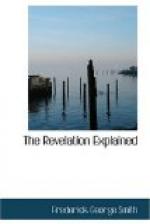This work of conducting a world-wide missionary enterprise may appear to be a gigantic task, but the seeming impossibility vanishes when we consider the fact (to be more fully developed hereafter) that God calls into this service all his people who are yet under the sectarian yoke. With this great host already dispersed over the world, the work of making known this last message can and will be accomplished.
The positive statement that the hour of his judgment is come shows that the end is exceedingly near; hence the second and third angels must follow the first in the closest proximity possible in order to introduce their messages before the wrath of God is poured out upon apostate Christendom. The time is so short that these three messengers can not possibly refer to three distinct reformations in the world; hence they must signify three important phases in the one last reformation that carries the gospel to all nations in the short period of an “hour,” which time also includes the final judgment.
A careful study of these three messages will show that they are inseparably connected. The second cry was against Babylon, that she had fallen. Rev. 18:1, 2 proves this fall of Babylon to be a moral one—a giving away to ungodliness, iniquity and all manner of deception. According to chapter 16:19 the great city of Babylon is composed of three parts, being a confederation of the dragon[10] (heathenism), the beast (Catholicism), and the false prophet (Protestantism). Chap. 16:13, 14. It is evidently to this latter division of Babylon that this second message applies; for Paganism was always a false religion, and Catholicism was always a corrupt one, during whose reign the church of God, as already shown, was separate. Protestantism, then, was the only part of the great city that could fall morally or spiritually. During the space of three hundred and fifty years, from the formation of the first Protestant creed, she held reign and authority over the people of God, who were scattered among her hundreds of opposing sects.
[Footnote 10: That the dragon should be a part of great Babylon seems at first improbable; but in this statement reference is made, not to the dragon in his original, or Pagan, state, but to the form in which he is manifesting himself in these last days to deceive the nations, working in conjunction with apostate Christendom. This phase of the dragon power which brings him into harmony with, and, in reality, a part of, modern Babylon, will be more clearly understood when we come to consider the three unclean spirits that come out of the mouth of the dragon, the beast, and the false prophet (chap. 16:13, 14), and the release of the dragon in chapter 20:7-9.]
In this condition the faithful children of God, although bearing the mark and name of the beast, longed for restoration of the divine, primitive standard; but in the cloudy atmosphere of that period they could not clearly discern the whole truth. Later, when the full tidings of the everlasting gospel came, there came also a revelation that Babylon is fallen and that God is calling his people out of confusion just before the end of time.




